13.04.2005
S. Klimov. HARDSHIP OF CALCULATION.
There are several types of brilliant calculators and tacticians. Some, like Mikhail Tal, impress with the counting speed, produce a lot of variations, see the multitude of opportunities, can penetrate deep into the variations, and, moreover, make this with an amazing ease. Others, who probably possess a natural tactical talent of the similar extent, don't take a great interest in a ramified calculating, but have brilliant short tactics. Capablanca was more than others famous for this ability (he invented the illustrious term - petite 'combinations'). Vishy Anand comes to mind when talking about the contemporary chess players. Obviously, such ability smoothly serves his owner in practice – the share of the short variations in practice is higher (especially if we consider quick controls), and the scrap rate in them is less than in the fantastic counting in Tal's style, where the fantasy often grows into a phantasmagoria and the pieces appear from the nonexistence five moves after they've disappeared from board.
In any case it would be a mistake to consider the formal qualities of the calculation (distance, discipline and speed) as the only traits that worth development. It seems that more important is the ability to see the required moves and to sow tares among the wheat while reducing the calculating flow of variations and avoiding any useless work. Not only to master this ability, but even simply to analyze the domain, where the role of intuition is so great, is very difficult. Actually one can draw a variation tree on paper (whisper to himself, imagine mentally etc.), organize there everything, carefully examine all the mentioned candidate moves and choose the best of them after comparing evaluations in the variation's endings. One has a lot of work, but at least it's clear what to do. It's quite a different situation when you don't see a tactical blow at the 2nd move of the chosen variation; and if this happens one game after another? Calculating trees won't help; one has to strengthen the tactical skills, to solve lots of difficult puzzles and to hope for an improvement of the tactical mastery. Certainly the vision is going to improve, however, this method can be scarcely considered as a panacea – the situation on board is original, and you're not the only one to solve usual puzzles.
And probably the point is not only in the tactical vision, but as well in the features of thinking that in the same situations force to neglect unconsciously something that in actual fact turns out to be by no means redundant. At least, it seems to me that the share of errors that are related to an involuntary exclusion of possibilities is really great in master's and grandmaster's practice.
This article is devoted to these ruses and hardships of purely psychological character which players face in process of variation counting and which allow to compensate for a 'rough computer' calculating.
I would divide the difficulties related to the selection of candidate moves into two groups.
The first one is connected with the particular features of human mind and belongs probably not only to chess, but to conflict activity in general.
The second one is connected with those purely chess models, which were inculcated in their minds already in Pioneer's Palaces. I mean the ideas about relative strength of pieces, good and bad squares, that force us to choose moves that are 'normal' in positional sense among the whole variety of possibilities.
The first part of the article is dedicated to the psychological difficulties.
As I think, the first reason of them lies in the peculiarities of concentration. On the one hand in the game one should pay primary attention to the location of main events, and constrict the board in calculating to its separate part. Otherwise one should take care of so many possibilities that the main of them will remain unexamined or not completely examined.
On the other hand, those parts of the board that fall out of the counting don't cease to exist and unexpected moves can change everything in the evaluations.
The second reason consists in the inactivity of mind that shows particularly in the determination of the candidate moves. The position on board and previous variations calculated during the game and on the whole the general samples learned by heart in childhood influence strongly the choice of the moves.
The vision of errors and at the same time the practical ruse that uses mistakes that will be described further, play a considerable role both in tactics and pure calculating, where it allows to see more possibilities than the opponent, and in positional struggle, since the latter to a great extent is build on the variation calculating.
Forced capture/capture rejection
The most natural thing to do in response to a capture is to consider another one...
E.Rosentalis – J. Shaw
Bad - Wiessee 2003

14...¤a5?! Black has underestimated: 14...¤:c3! 15.Јc2 ¤:b5! (15...e4? 16.b:c6 e:f3 17.c:b7 ¦b8 18.¤:f3 Ґ:c4 19.d:c4 ¤e2+ 20.Ј:e2 Ґ:a1 21.Ґf4; 15...Ґ:c4 16.d:c4 ¤e2+ 17.¦:e2 e4 18.¤:e4 Ґ:a1 19.b:c6 b:c6 20.Ґ:h6ќ) 16.Ґ:b5 e4 17.¤:e4 Ґ:a1 18.Ґ:h6 Ґg7 19.Ґ:g7 ў:g7 20.Ґ:c6 b:c6 21.Јc3+ f6 22.¤d4 Ґd5 23.¤c5 Јd6 24.¤de6+ Ґ:e6 25.¤:e6+ ўg8 26.¤:f8 ¦:f8І /= (Rozentalis variation).
15.Ґ:d5! Ґ:d5 16.Ґb2. White aims at the pawn e5 – it should be protected somehow, and the means chosen by Black turns out to be with rottenness.
16...¦e8. A serious weakening, but probably a relatively better solution would be 16...f6 17.c4 Ґ:f3 (with two survived black bishops it won't be that easy to convert the pawn after 17...Ґf7 18.Ґc3 b6 19.Ґ:a5 b:a5 20.¤b3 a6 21.¦:a5 a:b5 22.¦:b5 ¦b8) 18.¤:f3 a6 (or 18...b6 19.Ґc3 ¤b7 – the square e6 is weak, but this fact still should be used) 19.¤h4 g5 20.¤f5 a:b5 21.Ґa3 (21.Јh5 Јe8) 21...¦f7І.
17.c4 Ґ:f3 18.¤:f3 e4. Doesn't protect the pawn 18...Јc7 19.Ґ:e5 Ґ:e5 20.¦:e5 ¦:e5 21.¤:e5 Ј:e5 22.¦:a5; now it is already late for 18...f6 19.¤h4 g5 20.¤f5 – in comparison with the variations at the 16th move, Black has simply lost a tempo on ¦e8.
19.Ґ:g7 ў:g7

20.¤d2! Capture rejection that Black didn't take into account when calculating. He counted on 20.d:e4 Ј:d1 21.¦a:d1 ¤:c4 22.¦d7 ¦ed8= … ¤d6. Black loses the pawn because of the terrible knight a5 .
20...b6 [20...e:d3 21.¦:e8 Ј:e8 22.¦:a5; 20...Ј:d3 21.¦:a5 ¦ad8 22.Јa1+ќ] 21.¤:e4 Јd4 22.c5 ¦ad8 23.c6,and Whiteeasily exploits his advantage owing to the passer c6 (1–0).
"I've attacked –you've protected"
Y. Balashov – S.Kiselev
USSR 1991
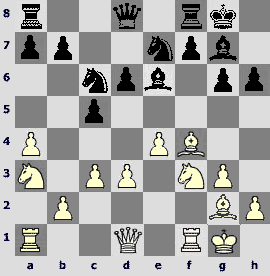
12.¤b5 a6! Didn't attack! 13.¤:d6. Probably the follower of Mark I. Dvoretsky could move the knight backward with a normal position...
13...g5! 14.¤:b7 Јb6 15.Ґ:g5 Ј:b7 16.Ґ:e7 Ј:e7 17.¤h4. The possession of the square f5 turns out to be insufficientfor the compensation.
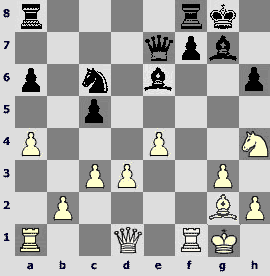
17...¦ad8 18.Јe2 ¦d7 19.¦ae1 ¤e5 20.¤f5 Јd8 21.Јh5 Ґ:f5 22.e:f5 Јf6 0–1
A.Kharlov – A.Shirov C88
USSR 1991
1.e4 e5 2.¤f3 ¤c6 3.Ґb5 a6 4.Ґa4 ¤f6 5.0–0 b5 6.Ґb3 Ґb7 7.d3 Ґe7 8.¤bd2 0–0 9.¦e1 ¦e8 10.¤f1 ¤a5!?
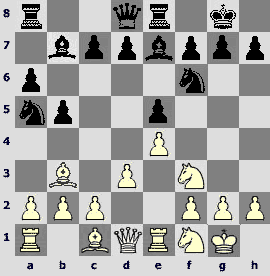
An interesting idea. White thinks that for the time being there's nothing to protect the pawn e5, black king is immovable, and therefore, the Spanish bishop is out of danger. The ideas of the Marshall Counter-Attack (10...d5), without c2-c3, cannot be very effective here. Nevertheless Black sacrifices a pawn, and his initiative turns out to be quite strong. In such a position in the Anti-Marshall with 8.h3 Alexei Bezgodov used the same idea ¤a5 and d5 twicewith 50 % score. In his game with A. Kovalev (Minsk 1998) 1.e4 e5 2.¤f3 ¤c6 3.Ґb5 a6 4.Ґa4 ¤f6 5.0–0 Ґe7 6.¦e1 b5 7.Ґb3 0–0 8.h3 ¤a5 9.¤:e5 ¤:b3 10.a:b3 Ґb7 11.d3 d5 12.e:d5 ¤:d5 13.¤c3 Ґf6 14.Ґd2 c5 15.Јf3 was played, and White received an advantage. Here, as we see the sacrifice is more favourable to Black. Firstly, possessing a pawn on h2 he has got a resource ¤g4-e5, secondly, White knight is forced to move from e5 straight away.
11.¤:e5 ¤:b3 12.a:b3 d5 13.e:d5 Ј:d5 14.¤f3. Not good is 14...Ґd6 15.Ј:d5 ¤:d5 16.¤f3 ¤b4 17.¦:e8+ (17.¤e3? ¦:e3) 17...¦:e8 18.¤e3 Ґ:f3! (18...Ґf4 19.¤e1±) 19.g:f3 Ґf4 20.d4 ¦e6 21.c3 ¤d3!і (А.Kharlov).
14...Ґd6© 15.Ґg5 [15.¤g3 ¤g4 16.c4 Јc6© … ¤e5; 15.¤e3 Јh5 16.h3 ¦ad8©] 15...¦:e1. А.Shirov gives a variation 15...¤g4!? 16.¦:e8+ ¦:e8 17.Ґh4 ¤e5 18.Ґg3! (18.¤1d2 f5! – the bishop on h4 is in danger) 18...¤:f3+ 19.Ј:f3 Ј:f3 20.g:f3 Ґ:f3 21.¤d2! (21.¦:a6? ¦e1°) 21...Ґb7 22.¤e4 is equal, however Black can still play here: 22...Ґf8 … ¦e6.
16.Ј:e1 ¤g4
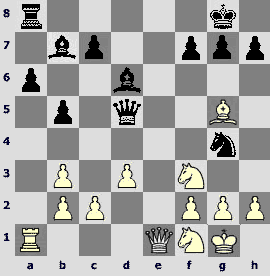
17.Ґe7!? He's trying to escape a draw by sacrificing the queen for a rook and a bishop. However the grave danger of White's position is quite doubtful:
Not good is 17.¤e3? Ґ:h2+µ or 17.Ґh4 ¤e5 18.¤1d2 ¤:f3+ 19.¤:f3 Јh5µ; quite unpleasant is 17.Јe2 ¤e5 18.¤1d2 ¦e8ѓ, but why not to take the perfect square e5 away from the black knight by 17.d4 ? after this move the attempts of Black to gain any immediate benefits can be scarcely fulfilled, e.g.: 17...Јf5 (17...c5 18.h3) 18.Јe2 Јg6 19.¦e1.
17...¤e5 [17...¦e8 18.Ґ:d6 ¦:e1 19.¦:e1 h6 20.Ґb4›] 18.¤1d2 ¤:f3+ 19.¤:f3 ¦e8 20.Ґ:d6 ¦:e1+ 21.¦:e1 h6 22.Ґb4,and White has defended his fortress (Ѕ–Ѕ).
"Captured square"
V.Anand – G.Kamsky C89
India 1994
An absolutely brilliant tactical game.
1.e4 e5 2.¤f3 ¤c6 3.Ґb5 a6 4.Ґa4 ¤f6 5.0–0 Ґe7 6.¦e1 b5 7.Ґb3 0–0 8.c3 d5 9.e:d5 ¤:d5 10.¤:e5 ¤:e5 11.¦:e5 c6 12.d4 Ґd6 13.¦e1 Јh4 14.g3 Јh3 15.Ґe3 Ґg4 16.Јd3 ¦ae8 17.¤d2 ¦e6 18.a4 Јh5 19.a:b5 a:b5 20.¤e4. The move was invented by Vichy Anand after it's turned out that 20.¤f1 Ґf5 21.Јd1 Ґg4 22.Јd2 Јh3 23.Ґd1 Ґ:d1 24.¦a:d1 f5 25.f4 g5 is fruitless (Karpov – Short, Tilburg 1991, and Ljubojevic – Nikolic, Belgrade 1991).
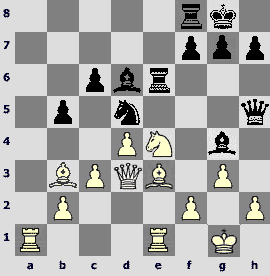
20...Ґc7. In the encounter Svidler – Kamsky, Groningen 1995, Black found an important improvement 20...Ґf5 21.Ґd2 ¦:e4 22.¦:e4 ¤f6 23.f3 Јg6, and since to 24.¦ae1 follows 24...Ґ:g3, Black regains a pawn with an equal game.
21.Ґd2 ¦fe8 22.Ґd1! An improvement as compared with the previous encounter of the same match where 22.¤c5? ¦:e1+ 23.¦:e1 ¦:e1+ 24.Ґ:e1 ¤f4! 25.g:f4 Ґ:f4 26.h4 was played, and here, instead of 26...Ґf3 that was chosen by Kamsky, following Anand, it would be possible win with 26...Ј:h4! 27.Јe4 Јh2+ 28.ўf1 Јh3+! 29.Јg2 (29.ўg1 Ґh2+ 30.ўh1 Ґf3+ 31.Ј:f3 Ј:f3+ 32.ў:h2 Јe2°) 29...Ґe2+ 30.ўg1 Ґh2+! 31.ўh1 Ґf3 32.Ј:f3 Ј:f3+ 33.ў:h2 Јe2°.
22...Ґ:d1 23.¦e:d1™ f5. The ruse consists in the fact that 23...¦:e4? 24.Ј:e4 Ј:d1+ 25.ўg2!ќloses.
24.¤g5 ¦e2 [24...¦h6 he moves the rook in offside: 25.h4 (25.¤f3 f4) 25...f4 26.¦e1 f:g3 27.f:g3 ¦f8 28.¤e6 ¦g6 29.Ґg5± h6 30.¤:f8 ў:f8 31.¦a8+ќ] 25.¤f3. A move with an idea to exchange all the rooks on the e-file and to convert an extra pawn. Hardly Anand didn't see at all that he could have captured a pawn: 25.Ј:f5! ¦f8 (25...¤f6!?) 26.Јh3 Јg6 27.Јg4, and the black rook should retreat, because it is loosing 27...¦e:f2 (27...¦f:f2 28.¦a8+ќ) 28.Јe6+ Ј:e6 29.¤:e6 ¦8f5 30.¦a8+ ўf7 31.¤:c7 … ¦a7ќ. 25.Јf3 is also quite good, it would force the queen to retreat. Something unbelievable has begun:
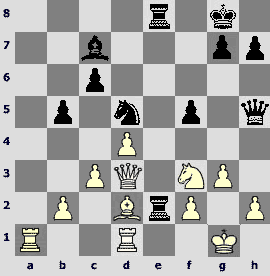
25...¦8e3! (it's obvious that Anand overlooked this) [25...f4 (P.Blatny) 26.¦e1±] 26.¦a8+ [26.Ґ:e3? Ј:f3°, and White has no protection from ¤:e3] 26...ўf7

27.¤g5+! ўg6! [27...Ј:g5? 28.Ј:e2!ќ] 28.Ґ:e3 ¤:e3 29.¦f1!™. One can feel dazzled because of the abundance of 'the only' sacrificing moves. The move in the encounter protects White later from the threat of Јf3 andЈf2+, and it's sufficient to move the rook on e3 in respond toЈf3. [29.¦e8 ¤g4!°; 29.h4 Ґ:g3µ].
29...ў:g5! [29...¤:f1 30.ў:f1 ¦:b2 31.¤f3± would allowWhite to consolidate his position while having a material advantage] 30.¦e8! It's clear that the rook is inviolable, because the black rook on e2 is also hanging. [30.h4+ ўh6 31.f:e3 Јg4 32.e4 f:e4°].
30...f4! In respond to 30...¤g4 there's an intermediate 31.h4+ќ; 30...Јf3? 31.¦:e3.
31.Јe4. Play for a win? It's better 31.h4+! ўh6 32.Јe4 g6 first, following Anand analysis, with a probable draw, the easiest way for White to attain it is 33.Јe7 Јf3 34.Јg5+ ўg7 35.¦e7+ ўg8 36.¦e8+=.
31...f:g3 [31...¤:f1? 32.h4+! ўh6 33.Ј:e2ќ]
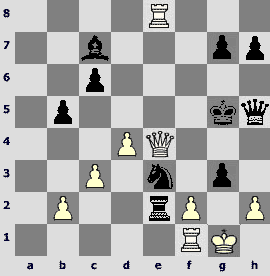
32.h4+! And here one needs to try hard to make a draw. [32.h:g3 Ґ:g3!°].
32...Ј:h4 33.Ј:h4+ ў:h4 34.¦e4+! [34.¦:e3?? g:f2+; 34.f:e3 ўh3] 34...ўh3 35.¦:e3 ¦:b2 36.¦e7! Ґf4 [36...g2? 37.¦e3+] 37.f:g3 ¦g2+ 38.ўh1 ¦h2+ 39.ўg1 ¦g2+ 40.ўh1 ¦h2+ 41.ўg1 Ґg5 42.¦e5 ¦g2+ 43.ўh1 Ѕ–Ѕ
" A backward move"
V.Anand – J.Benjamin B63
Wijk aan Zee 1989
1.e4 c5 2.¤f3 d6 3.d4 c:d4 4.¤:d4 ¤f6 5.¤c3 ¤c6 6.Ґg5 e6 7.Јd2 Ґe7 8.0–0–0 0–0 9.¤b3 Јb6 10.f3 ¦d8 11.ўb1 d5 12.Ґ:f6

12...d:e4?? One should be resigned to a worse play after 12...Ґ:f6 13.e:d5 Ґ:c3 14.Ј:c3 e:d5І.
13.Ґ:e7 ¦:d2

14.¤:d2! Black has missed this capture in his calculating. Now in contrast to 14.¦:d2, Black cannot seize the bishop e7, because ¤c4 and ¤b5 will force the black queen to take the threat of d8-square.
14...e:f3 [14...¤:e7? 15.¤c4 Јc7 16.¤b5ќ] 15.g:f3 [easier is 15.¤c4! Јc7 (15...Јf2 16.¤e4!ќ) 16.Ґd6!ќ] 15...e5 16.Ґh4. Is he waiting for a resignation? [16.¤c4!?].
16...Ґe6 17.¤de4, and Anand converted his material advantage, though with some adventures. (1–0).
"Move from the side"
The analogue to the mistake of the "blind spot" described by Blumenfeld. In course of the game a player inevitably constricts the "battlefield " to that parts of the board, where something is going on – someone attacks, invades, exchanges and so on. So if the events take place only in the centre, it's quite natural to overlook a flank move that can change the evaluations of all the variations.
V.Epishin – L.Yurtaev
USSR 1991
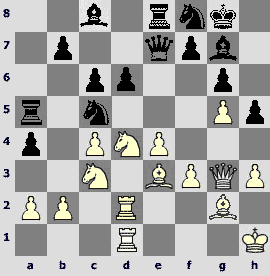
26.f4!±. Black has serious problems with the space and d6-pawn, which are typical for the whole opening though. However, the following operation leads him to the defeat very quickly, so it would have been better to be patient.
26...¤:e4? With another followings Black has worse situations: 26...¤fd7 27.f5 (27.¤de2!?) 27...Ґe5 28.Јf2 ¤b6 29.Јf1І (V.Epishin); 26...¦a8 27.¤de2 Ґe6 28.¦:d6 ¤fd7 29.Јf2 ¦a5 30.f5 g:f5 31.e:f5 Ґ:c4 32.Ґ:c5 ¤:c5 33.f6±.
27.¤:e4 d5
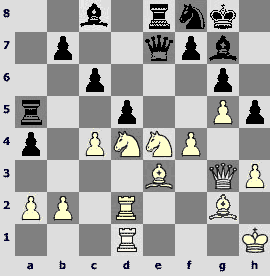
28.b4!!ќ. After this move the black rook is under the threat (in case of exchange) or forked (in case of retreat).
28...¦a8. In case of 28...a:b3 29.¤:b3 … c:d5 one still fails to capture a piece.
29.c:d5 c:d5 30.¤b5 h4™. The only way to continue the struggle. [30...d:e4 31.Ґc5 Јe6 32.¤c7].
31.Ј:h4! The idea of the last Black's move consists in the fact that in reply to 31.Јe1 (to keep the threats) will follow 31...Ґ:h3 32.Ґ:h3?! Ј:e4+ 33.Ґg2 Ј:e3.
31...Ј:b4 32.¤f6+! Ґ:f6 33.g:f6 ¦:e3 34.¦:d5 [34.Јh6 ¤e6 35.¦:d5 … ¦d8ќ] 34...¦a6 35.¤d6! Јc3 36.f5!ќ Ґd7 37.Јh6 ¦:h3+ 38.Ј:h3 Ј:h3+ 39.Ґ:h3 Ґc6 40.¤e4 1–0
V. Anand – A. Khalifman
Linares 2000
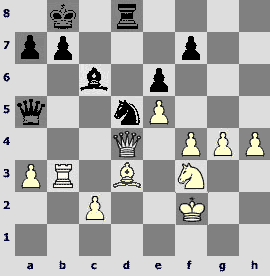
A position arose from the well known “Armenian variation” of the French defense –
1.e4 e6 2.d4 d5 3.¤c3 Ґb4 4.e5 c5 5. a3 Ґa5. Black gave the pawns g7 and h7 for a long-term initiative with the uncastled white king.
34...¤f6 35.Јb4 ¤:g4+ [№ 35...Јd5 36.Ґe2! ¤:g4+ 37.ўe1 ¦h8±] 36.ўg3 Јd5 [36...Ј:b4 37.¦:b4 ¦g8 38.¤g5ќ] 37.Ґh7!ќ

White takes over the control of a key square g8, impeding the black rook to attack. By the way, bystanders say that Anand had made this move almost without thinking!
37...Јd1 [37...Јd7 38.¦d3 Ґd5 39.ў:g4 f5+ 40.ўh3 Ј:h7 41.c4ќ] 38.ў:g4 ¦d2 [38...¦h8 39.Јd6+! Ј:d6 40.e:d6 ¦:h7 41.¤e5ќ] 39.ўg5! Ґ:f3 40.Ґd3 ¦g2+ 41.ўf6 a6 42.¦b1 [42.¦b1 Јd2 43.Ј:d2 ¦:d2 44.ў:f7] 1–0
'What are you doing?'
Mysterious moves, according to Aron Nimzovich’s terminology.
B. Larsen – S. Gligoric A04
1970
You can read more detailed annotations of this game in Mark Dvoretsky's article "The advancement of the rook pawns", published on our website, or in Larsen's book "50 selected games". Now I will dwell on only one aspect.
1g3 g6 2.Ґg2 Ґg7 3.e4 c5 4.¤f3 ¤c6 5.0–0 ¤f6 6.d3 0–0 7.¦e1 d6 8.¤bd2 ¦b8 9.a4 b6 10.¤c4 Ґb7

11.h4!? It looks quite mysterious, but it's evident that Black plans d6-d5, and then White can play h4-h5, so this strange move turns into the normal and even standard idea h4-h5xg6 or h5-h6 with the weakening Black's kingside.
11...Јc7 12.Ґd2 ¦bd8 13.Јc1 d5 (quite unsophisticated, however, Black doesn't have any plan but d6-d5) 14.Ґf4 Јc8 15.e:d5 ¤:d5 16.Ґh6 ¦fe8 17.Ґ:g7 ў:g7 18.h5 ¤f6 19.h6+ ўg8 20.Јf4 ¤h5 21.Јd2 f6
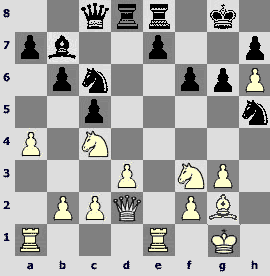
22.a5! b5 23.a6 Ґa8 24.¤a5 e5 25.Јc3 ¤d4 26.¤b7! Ґ:b7 27.a:b7 Ј:b7 28.¤:d4 c:d4 29.Ґ:b7 d:c3 30.b:c3 ¦e7 31.¦:a7 ўf8 32.¦b1 f5 33.¦:b5, and White converted the material advantage (1-0).
"You've just been there!"
L. Portisch – T. Petrosian A25
Tilburg 1982
A very original game.
1.c4 e5 2.¤c3 ¤c6 3.g3 g6 4.Ґg2 Ґg7 5.e3 d6 6.¤ge2 h5 7.d4 h4 8.d5 ¤b8 9.e4 Ґg4 10.Јa4+!?
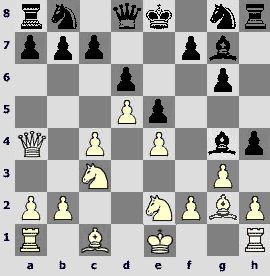
This is not the first original move made in the game. White wants to avoid exchanging the knight e2 for the black bishop. However, this is not an undisputable point of view, for example M. Botvinnik in the similar positions exchanged a knight and activated the bishop along h3-c8 diagonal. However, Black has already played h3-h4 and there is no standard h3-h4 … Ґh3.
10...ўf8!? 11.¤g1!? A continuation of the maneuver. 11...¤a6 12.f3 Ґd7 13.Јc2 ¤b4 14.Јe2 a5 15.Ґe3 ¤f6 16.0–0–0 Ґh6 17.Ґh3 ўg7 18.Ґ:d7 ¤:d7 19.¤h3 Ґ:e3+ 20.Ј:e3

20...¤b6!? Annoying move. 21.c5 [21.Јe2 c6 22.ўb1 c:d5 23.c:d5 ¦c8 similar to the game] 21...¤d7 22.c:d6 c:d6. Conceptually it should have been Black to strive for the opening of the "c"-file, while in the game White undertook that.
23.ўb1 ¦c8 24.¤f2 ¤b6! The same thing. 25.b3 [25.¦c1 ¤c4 26.Јe2 Јb6 looks troublesome for White; though the initiative is lost, at least "a"-file could be locked].
25...a4 26.¦c1 a:b3 27.a:b3 ¤d7 28.¤d3 Јa5 29.¤:b4 Ј:b4µ 30.¤a2 Јa3 31.¦:c8 ¦:c8 32.¦c1 ¦a8 33.¦c2 h:g3 34.h:g3 ¤c5 35.f4 [35.¦b2 ¦h8 36.¤c1 ¦h1µ] 35...¦a4 36.f:e5 ¦:e4 37.Јc3 ¦:e5°
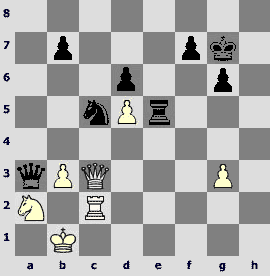
With an extra pawn and a better position. 38.¤c1 ¤e4 39.Јc8 ¦:d5 40.¦h2 ¦h5 41.¦:h5 g:h5 42.Ј:b7 d5 43.Јc7 Јb4 44.Јe5+ ўg6 45.Јe8 ¤f6 46.Јc6 Јe4+ 47.Јc2 ўg5 48.¤d3 Јe3 49.b4 ¤e4 50.b5 ¤d2+ 51.ўa2 Јa7+ 52.ўb2 ¤c4+ 53.ўc3 Јa1+ 54.¤b2 Јe1+ 55.ўb3 Ј:g3+ 0–1. It's interesting whether Portisch considered knight's moves on b6, especially the first one, as the idea is not typical for the King's Indian structure.
Planning mistake
If the previous moves of the opponent afford us a ground for suspecting a plan, it means that this plan will be carried out within the next few moves.
For instance, the opponent's previous move was c1-c2 – it means that he wants to double the rooks and his next move will certainly be f1-c1. But maybe the opponent wants to vacant the square for moving the bishop from c1 to a3?
J. Hjartarson - J. Ehlvest
Reykjavik 1991
1.d4 d5 2.c4 d:c4 3.e3 ¤f6 4.Ґ:c4 e6 5.¤c3 a6 6.¤f3 b5 7.Ґd3 Ґb7 8.0–0 c5 9.d:c5 Ґ:c5 10.a4?! A strange idea that could be explained only by the disappointment with the unsuccessful opening. 10...b4 11.¤e2?! [11.¤b1 0–0 12.Јe2›] 11...¤bd7 12.¤g3 [12.b3 Ґ:f3 13.g:f3 ¤e5]

12...h5! Black doesn't have to risk taking on f3 – it's obvious that there is no point in moving the knight on g3 within their plan. Perhaps he only had in view 12...0–0 13.b3 (13.e4 Ґd6 14.Јe2 ¤c5) 13...Ґ:f3 14.g:f3 ¤e5 15.Ґe2.
13.h4 Ґd6! 14.¤g5 ¤c5 15.Ґe2 Ґ:g3 16.f:g3 Ј:d1 17.Ґ:d1 a5!µ
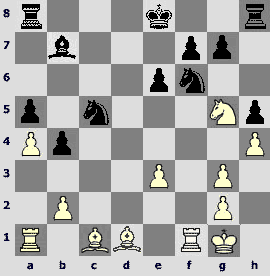
18.Ґf3 Ґ:f3 19.g:f3 ¤fd7 20.¦d1 ўe7 [20...¤b6?! 21.e4 ¤c:a4 22.Ґe3 ¤c4 23.¦:a4 ¤:e3 24.¦c1] 21.e4 f6 22.¤h3 ¤b3 23.¦b1 [23.¦a2 ¦hc8 24.Ґe3 ¦c2°] 23...¤e5 24.¦f1 ¦ac8°. White's position is almost hopeless – the queenside is paralyzed.
25.Ґf4 ¤c4 26.¦fd1 e5 27.Ґe3? ¤:e3 28.¦d3 ¤c4. White resigned, considering 29.¦:b3 ¤d2°. 0–1
'Structural stability' mistake
Any plan in the game is based on the pawn structure, its static weaknesses, objects of attack, pawn majority etc. It can be ruined usually by carefully planned actions. That's why the pawn structure seems to be so permanent, and one should sometimes pay for this mistake.
S. Reshevsky – V. Vaganian
Skopje 1976
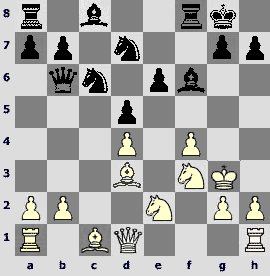
14.¦e1 White king castles by hand with a closed center...
14...e5!! 15.f:e5 ¤d:e5 16.d:e5 Ґh4+!! 17.ў:h4 ¦:f3! 18.¦f1 [18.g:f3 Јf2+ 19.ўg5 h6+ with a checkmate] 18...Јb4+ 19.Ґf4 Јe7+ 20.Ґg5 Јe6°

21.Ґf5 ¦:f5 22.¤f4 Ј:e5 23.Јg4 ¦f7 24.Јh5 ¤e7 25.g4 ¤g6+ 26.ўg3 Ґd7 27.¦ae1 Јd6 28.Ґh6 ¦af8 0–1. White loses a piece.
'Come on, take up your squares!'
I can't tell for the stronger players, but as well as the most players of my level I follow a principle that if someone tries to occupy an open file, the opponent should impede, or if White places the knight on d5, Black exchanges it for f6 knight within the next few moves, etc.
Meanwhile, in some modern opening systems Black ignores forced measures aimed against the opponent's pieces occupying the strategically important squares. In this regard I remember Zaitsev's observation on one of the most sly chess players Tigran Petrosian, particularly about the secret strength and excellent position of Black's knight on the square... e8!
Or take a fashionable Chebanenko variation, in which Black at first rejects freeing breaks e6-e5 or c6-c5, and later, having weakened c6, he easily gives the c-file away to the opponent, planning to drive him gradually out afterwards.
It is difficult to play against such a strategy for a straightforward chess player – at a certain moment he can't guess a single opponent's move.
C. Lutz – J. Piket
Germany 2003
1.e4 e5 2.¤f3 ¤c6 3.Ґb5 a6 4.Ґa4 ¤f6 5.0–0 Ґe7 6.¦e1 b5 7.Ґb3 d6 8.c3 0–0 9.h3 ¤a5 10.Ґc2 c5 11.d4 Јc7 12.¤bd2 c:d4 13.c:d4 Ґd7 14.¤f1 ¦ac8 15.¤e3 ¦fe8.The main variation here is 15...¤c6 16.d5 ¤b4 17.Ґb1 a5 18.a3 ¤a6 19.b4 – in view of the variation 19...a:b4 20.a:b4 ¤:b4?? 21.Ґd2 White leaves Black with a traditionally bad knight but it's still a question whether his own position is much better. At least this variation as well as Chigorine's system with an exchange on d4 experiences an uplift.
16.b3 ¤c6 17.Ґb2
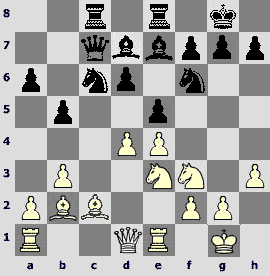
It's clear that Nd5 is the main resource of White in the struggle for the advantage in the arisen position. In case of the exchange on d5, this move will allow him to open the diagonals for the bishops, and to attack the king afterwards. If a strong knight on d5 survives at the outpost, he will provide White with the advantage.
17...Ґd8. Starting with this move, Black carries out an interesting strategy of 'bypassing' the white knight. All his pieces are driven away from knight's attacks and gradually it becomes unclear what this knight should do!
18.¦c1 [18.¤d5 ¤:d5 19.e:d5 ¤b4] 18...Јa7. This time Black takes the queen away.

19.¤d5 [19.Јd2 Ґa5; 19.Ґb1 ¤:d4; 19.d5 ¤b4 20.Ґb1 ¦:c1 21.Ј:c1 a5 22.a3 ¤a6= - the knight comes on c5; 19.a3 Ґb6„ (19...e:d4 20.¤:d4 ¤:e4 21.Ґ:e4 ¦:e4 22.¤df5ѓ) ]
19...h6. No further action in the center is advantageous for Black:
19...¤:d5 20.e:d5 ¤:d4 21.Ґ:d4 e:d4 22.¦:e8+ Ґ:e8 23.Ґ:h7+ќ, and White wins the exchange; 19...e:d4 20.¤:d4 ¤:d5 21.¤:c6 ¦:c6 22.e:d5 ¦:e1+ 23.Ј:e1 ¦c7 24.Јe4 g6 25.Јf4 Ґe7 26.¦e1ќ. The text move hardly comes easily to one's mind, although sometimes the similar ideas of brining a piece on g5 with a following exchange for f6 knight or a dark-squared bishops occur in practice in different openings,.
20.d:e5. After 20.Јd2 correct is 20...¤h7!, as in the game
(20...Ґa5 21.¤:f6+ g:f6 22.Ј:h6 Ґ:e1 23.¦:e1‚ with a terrible attack; loses
20...¤:d5 21.e:d5 ¤:d4 22.Ґ:d4 e:d4 23.¦:e8+ Ґ:e8 24.Ґh7+ќ; 20...¤:d4 21.¤:d4 ¤:d5 22.e:d5 Ґg5 23.Јd3 Ґ:c1 24.Јh7+ ўf8 25.¦:c1 e:d4 26.Јh8+ ўe7 27.Ј:g7ќўd8 28.Ґ:d4 Јb7 29.Ј:f7 with material equality and an attack)
a) 21.h4 ¤f6› - Why does White need a proud pawn h4?; 21...Ґg4 22.Ґd1 Ґ:f3 (22...Ґe6 23.d:e5 d:e5 24.¤:e5 ¤:e5 25.Ґ:e5 ¦:c1 26.Ј:c1 Ґ:h4 27.Јd2І) 23.Ґ:f3 Ґ:h4 24.Ґg4 Ґg5 25.f4±; 21...¤f8 22.¤b4;
b) 21.Јe3 ¤g5 22.d:e5 Ј:e3 (22...d:e5) 23.f:e3 d:e5 24.ўh2І;
с) 21.¦ed1 ¤g5 22.¤:g5 Ґ:g5 23.f4 e:f4 24.¤:f4 d5 25.e:d5 ¤b4µ.
The following continuations lead to a good play of White 20.Јd3 e:d4 21.¤:d4 ¤e5 22.Јg3 ¤:d5 23.e:d5 Ґf6 and 20.Ґb1 ¤:d4 21.¤:d4 ¦:c1 22.Ј:c1 e:d4=.
I think the correct idea is 20.a3!?, to activate the bishop after b3-b4:
20...¤h7 [20...e:d4 21.¤:d4І ¤:d5 22.¤:c6 Ґ:c6 23.e:d5 ¦:e1+ 24.Ј:e1 Ґd7 25.Ґh7+ (25.Јe4 f5 26.Јd3І) 25...ў:h7 26.¦:c8 Ґ:c8 27.Јc3 Ґf6 28.Јc2+ g6 29.Ґ:f6 Јc5 30.Јb2]
a) 21.b4 ¤g5 22.Ґb3 ¤:f3+ 23.Ј:f3 ¤:d4;
b) 21.Јd3 ¤g5 22.d:e5 (22.¤:g5 Ґ:g5 23.f4 Ґd8) 22...d:e5 23.¦ed1 ¤:f3+ 24.Ј:f3 Ґg5 25.¦b1 Ґe6„;
c) 21.d:e5 d:e5 22.b4 ¤g5 23.Ґb3 ¤:f3+ 24.Ј:f3І.
20...d:e5 21.Ґb1 [21.a3!? ¤h7 22.b4 ¤g5 23.Ґb3І] 21...¤h7 22.Јd3
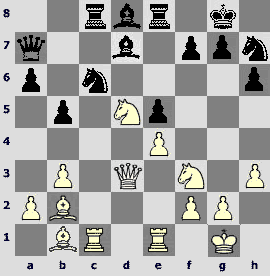
What is White's strong knight busy with? Ѕ–Ѕ
The annotations of V. Anand, A. Shirov, V. Epishin, L. Yudasin, E. Rozentalis, M. Dvoretsky, L. Ftachnik, B. Larsen were used.
